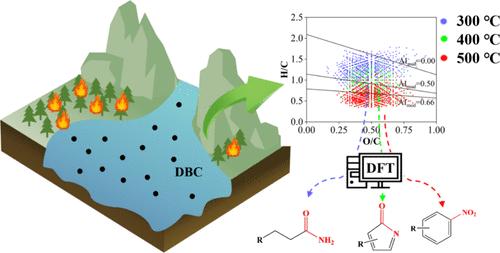当前位置:
X-MOL 学术
›
Environ. Sci. Technol.
›
论文详情
Our official English website, www.x-mol.net, welcomes your feedback! (Note: you will need to create a separate account there.)
Revealing Molecular Structures of Nitrogen-Containing Compounds in Dissolved Black Carbon Using Ultrahigh-Resolution Mass Spectrometry Combined with Thermodynamic Calculations
Environmental Science & Technology ( IF 10.8 ) Pub Date : 2024-06-27 , DOI: 10.1021/acs.est.4c01829 Zhiyuan Zhang 1 , Xiurui Cui 1 , Xiaolei Qu 2 , Heyun Fu 2 , Shu Tao 1 , Dongqiang Zhu 1
Environmental Science & Technology ( IF 10.8 ) Pub Date : 2024-06-27 , DOI: 10.1021/acs.est.4c01829 Zhiyuan Zhang 1 , Xiurui Cui 1 , Xiaolei Qu 2 , Heyun Fu 2 , Shu Tao 1 , Dongqiang Zhu 1
Affiliation

|
Landscape wildfires generate a substantial amount of dissolved black carbon (DBC) annually, yet the molecular nitrogen (N) structures in DBC are poorly understood. Here, we systematically compared the chemodiversity of N-containing molecules among three different DBC samples from rice straw biochar pyrolyzed at 300, 400, and 500 °C, one leached dissolved organic carbon (LDOC) sample from composted rice straw, and one fire-affected soil dissolved organic matter (SDOMFire) sample using Fourier-transform ion cyclotron resonance mass spectrometry (FT-ICR MS). N-Containing molecules contributed 20.0%, 36.1%, and 43.7% of total compounds in Combined DBC (pooling together the three DBC), LDOC, and SDOMFire, respectively, and molecules with fewer N atoms had higher proportions (i.e., N1 > N2 > N3). The N-containing molecules in Combined DBC were dominated by polycyclic aromatic (62.2%) and aromatic (14.4%) components, while those in LDOC were dominated by lignin-like (50.4%) and aromatic (30.1%) components. The composition and structures of N-containing molecules in SDOMFire were more similar to those in DBC than in LDOC. As the temperature rose, the proportion of the nitrogenous polycyclic aromatic component in DBC significantly increased with concurrent enhanced oxidation and unsaturation of N. As indicated by density functional theory (DFT)-based thermodynamic calculations, the proportion of aliphatic amide N decreased from 23.2% to 7.9%, whereas that of nitroaromatic N increased from 10.0% to 39.5% as the temperature increased from 300 to 500 °C; alternatively, the proportion of aromatic N in the 5/6 membered ring remained relatively stable (∼31%) and that of aromatic amide N peaked at 400 °C (32.7%). Our work first provides a comprehensive and thorough description of molecular N structures of DBC, which helps to better understand and predict their fate and biogeochemical behavior.
中文翻译:

利用超高分辨率质谱结合热力学计算揭示溶解黑碳中含氮化合物的分子结构
景观野火每年会产生大量溶解黑碳 (DBC),但人们对 DBC 中的分子氮 (N) 结构知之甚少。在这里,我们系统地比较了来自于 300、400 和 500 °C 热解的稻草生物炭的三种不同 DBC 样品、一种来自堆肥稻草的浸出溶解有机碳 (LDOC) 样品和一种火烧的含氮分子的化学多样性。使用傅里叶变换离子回旋共振质谱 (FT-ICR MS) 分析受影响的土壤溶解有机物 (SDOM Fire ) 样品。含氮分子分别占组合 DBC(将三个 DBC 合并在一起)、LDOC 和 SDOM Fire 中总化合物的 20.0%、36.1% 和 43.7%,并且 N 原子较少的分子具有较高的比例(即 N 1 > N 2 > N 3 )。组合DBC中的含氮分子以多环芳香族(62.2%)和芳香族(14.4%)组分为主,而LDOC中的含氮分子以类木质素(50.4%)和芳香族(30.1%)组分为主。 SDOM Fire 中含氮分子的组成和结构与DBC比LDOC更相似。随着温度升高,DBC中含氮多环芳香族组分的比例显着增加,同时N的氧化和不饱和度增强。基于密度泛函理论(DFT)的热力学计算表明,脂肪族酰胺N的比例从23.2%下降随着温度从300℃升高到500℃,硝基芳香族N的含量从10.0%增加到39.5%;或者,5/6 元环中芳香族 N 的比例保持相对稳定(~31%),芳香酰胺 N 的比例在 400 °C 时达到峰值(32.7%)。 我们的工作首先对 DBC 的分子 N 结构进行了全面、透彻的描述,这有助于更好地理解和预测它们的命运和生物地球化学行为。
更新日期:2024-06-27
中文翻译:

利用超高分辨率质谱结合热力学计算揭示溶解黑碳中含氮化合物的分子结构
景观野火每年会产生大量溶解黑碳 (DBC),但人们对 DBC 中的分子氮 (N) 结构知之甚少。在这里,我们系统地比较了来自于 300、400 和 500 °C 热解的稻草生物炭的三种不同 DBC 样品、一种来自堆肥稻草的浸出溶解有机碳 (LDOC) 样品和一种火烧的含氮分子的化学多样性。使用傅里叶变换离子回旋共振质谱 (FT-ICR MS) 分析受影响的土壤溶解有机物 (SDOM Fire ) 样品。含氮分子分别占组合 DBC(将三个 DBC 合并在一起)、LDOC 和 SDOM Fire 中总化合物的 20.0%、36.1% 和 43.7%,并且 N 原子较少的分子具有较高的比例(即 N 1 > N 2 > N 3 )。组合DBC中的含氮分子以多环芳香族(62.2%)和芳香族(14.4%)组分为主,而LDOC中的含氮分子以类木质素(50.4%)和芳香族(30.1%)组分为主。 SDOM Fire 中含氮分子的组成和结构与DBC比LDOC更相似。随着温度升高,DBC中含氮多环芳香族组分的比例显着增加,同时N的氧化和不饱和度增强。基于密度泛函理论(DFT)的热力学计算表明,脂肪族酰胺N的比例从23.2%下降随着温度从300℃升高到500℃,硝基芳香族N的含量从10.0%增加到39.5%;或者,5/6 元环中芳香族 N 的比例保持相对稳定(~31%),芳香酰胺 N 的比例在 400 °C 时达到峰值(32.7%)。 我们的工作首先对 DBC 的分子 N 结构进行了全面、透彻的描述,这有助于更好地理解和预测它们的命运和生物地球化学行为。











































 京公网安备 11010802027423号
京公网安备 11010802027423号